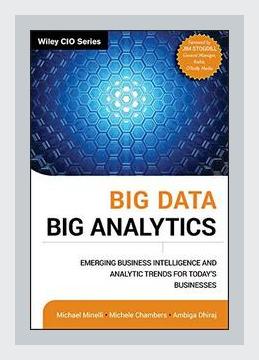Business StrategyCorporate Strategy
Big Data, Big Analytics: Emerging Business Intelligence and Analytic Trends for Today’s Businesses
Authors: Michael Minelli, Michele Chambers, Ambiga Dhiraj
Category: Corporate Strategy
Introduction
“Big Data, Big Analytics” examines the transformative impact of big data and advanced analytics on modern businesses. The book delves into how enterprises can harness these technologies to derive valuable insights, enhance decision-making, and drive competitive advantage. Here, we summarize the major points from the book and provide actionable steps for leveraging the advice.
1. Understanding Big Data and Its Importance
Major Point:
Big Data is defined by its volume, velocity, variety, and veracity. It enables organizations to analyze large datasets for patterns that can inform strategic decisions.
Example:
Retail giants like Walmart use big data to manage inventory and optimize supply chains, analyzing vast amounts of sales data for trends.
Actionable Step:
Set up a data infrastructure that can handle high volumes and different types of data. Invest in a robust data storage and processing system such as Hadoop or Apache Spark.
2. The Evolution of Analytics
Major Point:
Analytics has evolved from descriptive (what happened) to diagnostic (why it happened), predictive (what could happen), and prescriptive (what should be done).
Example:
Financial firms use predictive analytics to assess credit risks and tailor loan products to individual customers.
Actionable Step:
Adopt advanced analytics tools. Start with diagnostic and predictive analytics to understand past trends and forecast future events, and gradually transition to prescriptive analytics for strategic decision-making.
3. Big Data Architecture and Platforms
Major Point:
A big data platform integrates various technologies to collect, store, process, and analyze data efficiently. Key components include data sources, storage solutions, data processing engines, and analytics tools.
Example:
Amazon uses an integrated big data architecture to manage data from customer transactions, website clicks, and social media interactions, enhancing customer recommendations.
Actionable Step:
Implement a scalable big data platform that aligns with your firm’s data needs. Leverage cloud-based solutions such as Amazon Web Services (AWS) or Google Cloud Platform (GCP) for scalability and flexibility.
4. Real-Time Analytics
Major Point:
The ability to analyze data in real-time offers significant advantages, such as immediate insights and faster decision-making.
Example:
Financial trading firms use real-time analytics to monitor market conditions and execute trades instantaneously, minimizing risks and maximizing gains.
Actionable Step:
Deploy real-time analytics tools like Apache Kafka or Apache Flink to process streaming data. Set up dashboards for real-time monitoring and prompt decision-making.
5. Data Governance and Security
Major Point:
Effective data governance ensures data quality, security, and compliance with regulations. It is critical for building trust and making reliable decisions.
Example:
Healthcare institutions adhere to rigorous data governance to protect patient information and comply with HIPAA regulations.
Actionable Step:
Establish a data governance framework involving policies, roles, and procedures for data management. Use data encryption and access controls to secure sensitive information.
6. The Role of Data Scientists
Major Point:
Data scientists play a crucial role in extracting value from big data. They combine expertise in mathematics, statistics, and domain knowledge to uncover insights.
Example:
Netflix employs data scientists to analyze viewing patterns and personalize content recommendations to enhance user engagement and retention.
Actionable Step:
Invest in recruiting and training data scientists. Encourage cross-functional collaboration between data scientists and business units to align analytics efforts with business objectives.
7. Leveraging Social Media Data
Major Point:
Social media generates vast amounts of user-generated content that companies can analyze to understand consumer sentiment and behavior.
Example:
Brands like Coca-Cola use social media analytics to gauge public sentiment about their products and campaigns, adjusting strategies accordingly.
Actionable Step:
Integrate social media analytics tools to your big data platform. Monitor brand mentions, analyze sentiment, and use insights to refine marketing strategies.
8. Predictive Maintenance in Manufacturing
Major Point:
Predictive maintenance uses predictive analytics to foresee and prevent equipment failures, thus reducing downtime and maintenance costs.
Example:
General Electric uses predictive analytics to monitor the health of its jet engines, predicting maintenance needs before failures occur.
Actionable Step:
Deploy predictive maintenance solutions using sensors and IoT (Internet of Things) technologies. Develop models to predict failures and schedule maintenance proactively.
9. Enhancing Customer Experience
Major Point:
Big data analytics enables businesses to personalize interactions and improve customer experience, leading to higher satisfaction and loyalty.
Example:
Starbucks uses data from its loyalty program to personalize offers and promotions, driving customer loyalty and increasing sales.
Actionable Step:
Collect customer data through loyalty programs and other interactions. Use analytics to understand preferences and tailor offerings to individual customers’ needs.
10. The Future of Big Data and Analytics
Major Point:
The field of big data and analytics is rapidly evolving, with new technologies and methodologies continually emerging.
Example:
Businesses are now exploring the potential of AI and machine learning for even deeper and more automated data analysis.
Actionable Step:
Stay updated with the latest trends and technological advancements. Invest in continuous learning and experimentation with new tools to stay ahead in the competitive landscape.
Conclusion
“Big Data, Big Analytics” underscores the profound impact of big data on business strategy and operations. By understanding and implementing the principles and technologies discussed, businesses can gain unprecedented insights, optimize processes, and drive growth.
Key Takeaways and Actions:
- Set Up Data Infrastructure: Invest in scalable data storage and processing platforms.
- Adopt Advanced Analytics: Gradually implement diagnostic, predictive, and prescriptive analytics.
- Deploy Real-Time Analytics: Use tools for real-time data processing and decision-making.
- Establish Data Governance: Create policies and secure data management procedures.
- Recruit Data Scientists: Build a skilled data science team.
- Integrate Social Media Analytics: Monitor and analyze social media for consumer insights.
- Implement Predictive Maintenance: Use IoT and predictive models for equipment monitoring.
- Enhance Customer Experience: Personalize interactions using customer data.
- Stay Updated: Continuously explore new technologies and trends in big data analytics.
By following these actionable steps, businesses can effectively leverage big data to stay competitive and thrive in the dynamic business environment.
